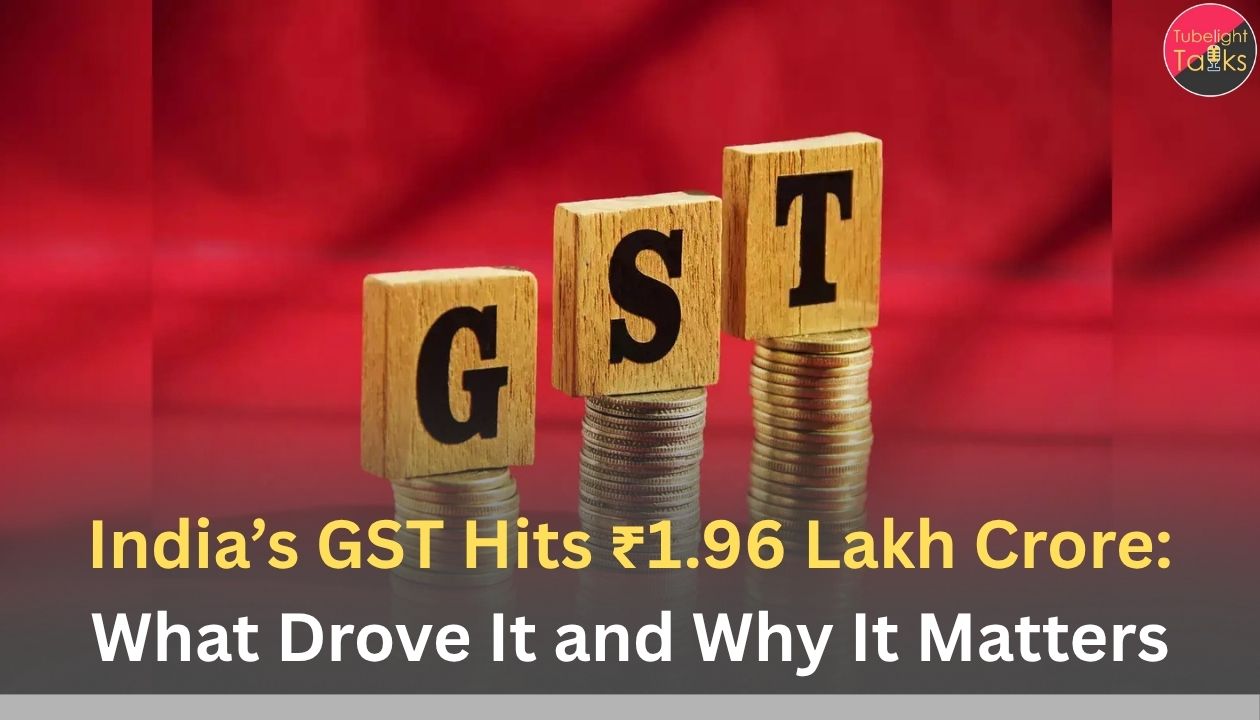India’s GST Hits ₹1.96 Lakh Crore: India’s gross Goods and Services Tax (GST) revenue for October 2025 printed at ₹1,95,936 crore, up 4.6% year-on-year, according to an official press release. Within this, domestic GST rose 2% to ₹1,45,052 crore, while import-related GST logged a stronger 12.9% growth—pointing to resilient trade activity even as a late-September rate rationalisation filtered through collections. Net GST, after refunds, stood at ₹1,69,002 crore, with refunds jumping nearly 40% year-on-year, reflecting faster processing. We break down the drivers, the fine print behind domestic vs import momentum, the festival season effect, and the policy context heading into November–December.
The October Print: What the Official Release Shows
The Press Information Bureau (PIB) note pegs gross GST at ₹1,95,936 crore, with CGST ₹36,547 crore, SGST ₹45,134 crore, IGST ₹1,06,443 crore, and Compensation Cess ₹7,812 crore. The release flags 4.6% year-on-year growth versus October 2024 (₹1,87,346 crore) and underscores a 2% rise in domestic collections alongside a 12.9% jump in import-linked revenue.
A companion PDF highlights net GST ₹1,69,002 crore and the scale-up in refunds—useful context for understanding why net revenue grew slower than gross.
Why the “gross vs net” gap widened
Refunds—especially export-linked—surged in October, contributing to a 39–40% year-on-year jump. That’s consistent with front-loaded processing and the export cycle catching up with festive shipping patterns. Netting these out yields ₹1,69,002 crore. For CFOs and treasury teams, this difference matters when forecasting government cash transfers to states and assessing working-capital timelines on refunds.
Festive Demand vs Rate Rationalisation: Tug-of-War in the Data
October was the first full month after a September 22 GST rate cut on select products (e.g., some FMCG and small cars). Despite the revision, gross collections rose as festive demand and compliance improvements offset price-line effects. Analysts quoted in coverage note that some impact of lower rates may appear with a lag as invoices settle and credits flow through. That makes the +4.6% year-on-year print an important resilience signal going into Diwali-season November.
Domestic vs import momentum
- Domestic GST (+2%): Slower than headline, suggesting some softness or rate-cut drag in certain categories even as festival sales propped volumes.
- Import GST (+12.9%): Stronger trade activity—think electronics, components, seasonal goods—helped compensate. This mix boosted IGST share within the gross number.
Year-to-Date (Apr–Oct FY26): Still on Track
Through April–October FY26, gross GST collections reached about ₹13.89 lakh crore, up from ₹12.74 lakh crore in the same period last year—roughly 9% higher. The run-rate keeps FY26 tracking near last year’s record, with the caveat that November–January will fully reveal the elasticity to September’s rate moves.
Inside the Basket: What the Composition Implies
The October split—IGST over ₹1.06 lakh crore—underlines trade momentum. Elevated IGST can signal healthier imports or stronger inter-state supplies; coupled with a moderate cess print (₹7,812 crore), it implies demerit-goods buoyancy wasn’t the prime driver. For planners, the CGST/SGST take (~₹36.5k/₹45.1k crore) provides a rough lens on Centre-state revenue sharing ahead of December’s devolution schedule.
Refunds: The quiet efficiency story
Refunds reportedly rose nearly 40%, with both domestic and import-related refunds stepping up. This is consistent with state-level pushes to clear backlogs and deploy analytics-driven verification. Faster refunds cut exporters’ working-capital friction and, paradoxically, can lower net GST without undermining the underlying demand story.
Why the Number Isn’t Higher: Three Frictions to Watch
- Rate rationalisation drag: The September 22 cut lowered effective tax on some categories, mechanically trimming the take—effects may amplify as credits settle.
- Pre-festive pause in durable purchases: Some buyers delayed buys into November mega-sales, flattening October’s domestic line. (Retail channel checks typically show this cadence.)
- Refund acceleration: Good for exporters, but lowers net revenue growth optics in-month.
What It Means for Households and Businesses
- Prices: Rate cuts plus festival discounts have already eased tags in a few FMCG and auto sub-segments; further pass-through depends on channel inventory and promotional intensity.
- Corporate margins: If rate reductions are passed through, margin dilution is possible in price-sensitive categories; however, volume uplift around festivals can cushion EBIT.
- Working capital: Exporters should benefit from faster refunds; ensure invoice hygiene to avoid “error-mismatch” holds.
- State finances: With SGST ₹45,134 crore and healthy IGST settlement pipeline, most states remain funded for near-term obligations; watch how devolution and compensation cess transfers land in November.
Policy Context: The Road Ahead for GST
The government flagged rate simplification and slab tweaks into the festive window; economists note a trade-off between revenue buoyancy and consumer relief. The October math suggests resilience despite lower rates, but November–December will test the durability as promotional seasons peak and base effects get trickier. Watch for GST Council cues on slab mergers, compliance roadmap, and continued refund process improvements.
Official voice, in brief
The PIB release’s headline—“GST Revenue Soars in October 2025”—emphasises the month’s gross tally and the domestic vs import dynamics, a framing consistent with seasonal strength and a cautious nod to the rate-cut backdrop.
Sector Lenses: Where the Collections Are Coming From (and Going To)
Electronics & Appliances
Festive launches and imports of components/devices tend to lift IGST, matching the +12.9% import GST growth. Watch November’s consumer-electronics sell-through to judge whether October’s pipeline sticks.
Auto & Two-Wheelers
Selective rate changes and pre-Diwali booking cycles can shift billing across months. If sales spilled into November, we could see domestic GST catch-up in the next print.
Apparel & Footwear
Promotions pull forward volumes but may compress value realisations, flattening domestic GST. The net effect becomes clearer with November clearance cycles.
Export-linked supply chains
Refund optimisation benefits exporters in textiles, pharma, and engineering. Faster refunds reduce cash-flow pain; ensure e-invoice integrity to avoid mismatches.
Quick Reference Figures (October 2025)
- Gross GST: ₹1,95,936 crore (+4.6% y/y).
- Domestic GST: ₹1,45,052 crore (+2% y/y).
- Import GST growth: +12.9% y/y.
- Net GST: ₹1,69,002 crore.
- Component split: CGST ₹36,547 cr, SGST ₹45,134 cr, IGST ₹1,06,443 cr, Cess ₹7,812 cr.
- Apr–Oct FY26 cumulative: ₹13.89 lakh crore (+~9% y/y).
Outlook: What to Watch in November–December
- Diwali sales effect: Expect a stronger domestic line in the November print if purchase deferrals materialised in October.
- Pass-through intensity: Track FMCG/auto pricing statements for how fully the September 22 cuts are passed on.
- Council signals: Any slab-merger hints or compliance-easing updates will shape Q4 expectations.
Fairness in Tax—and in Trade
Taxes fund public goods, but how we collect and comply also matters. A fair system asks firms and citizens to be truthful in declarations, punctual in dues, and considerate of the ripple effects on workers and small suppliers.
Spiritual leader Sant Rampal Ji Maharaj guidance accessible to everyone emphasises honest earnings, non-exploitation, and responsible conduct—virtues that translate neatly into everyday tax behaviour: issuing accurate invoices, paying what is due, and choosing transparency over shortcuts.
For readers who value this perspective, resources on ethical work and righteous conduct offer a practical complement to policy: do the right thing because it’s right, not only because the law demands it.
Use the October Print to Make Smarter Q3 Decisions
Align Pricing, Compliance, and Cash Flow
- Reprice judiciously where GST rates fell—share gains with consumers but preserve viability by betting on volume-led margin.
- Tighten reconciliation: cure GSTR-1/3B/2B mismatches weekly; pre-empt scrutiny on high-refund claims with a clean audit trail.
- Plan imports smartly: if IGST credits are rising, ensure credit utilisation is mapped to output tax to avoid blockage.
- Engage state helpdesks for refunds; document e-invoice flows end-to-end.
Read Also: GST Rates Slashed 2025: What’s Cheaper and What It Means for You
FAQs: India’s GST Hits ₹1.96 Lakh Crore
Q1. What was India’s GST collection in October 2025?
₹1,95,936 crore, up 4.6% year-on-year, per the official PIB release.
Q2. How did domestic vs import GST perform?
Domestic GST rose 2% to ₹1,45,052 crore; import-related GST grew 12.9% year-on-year.
Q3. What was net GST after refunds?
₹1,69,002 crore; refunds jumped nearly 40%, contributing to the gross-net gap.
Q4. Did late-September rate cuts dent collections?
Collections still rose +4.6% y/y; analysts note the price-cut impact can lag, so November–December prints will tell more.
Q5. How are collections trending in FY26 so far?
April–October FY26 gross GST is about ₹13.89 lakh crore, ~9% higher year-on-year.
Q6. Where can I read the official release and data tables?
See PIB’s press note and the supporting PDF/table from the GST portal; major outlets like Reuters and ET also summarised the print.










